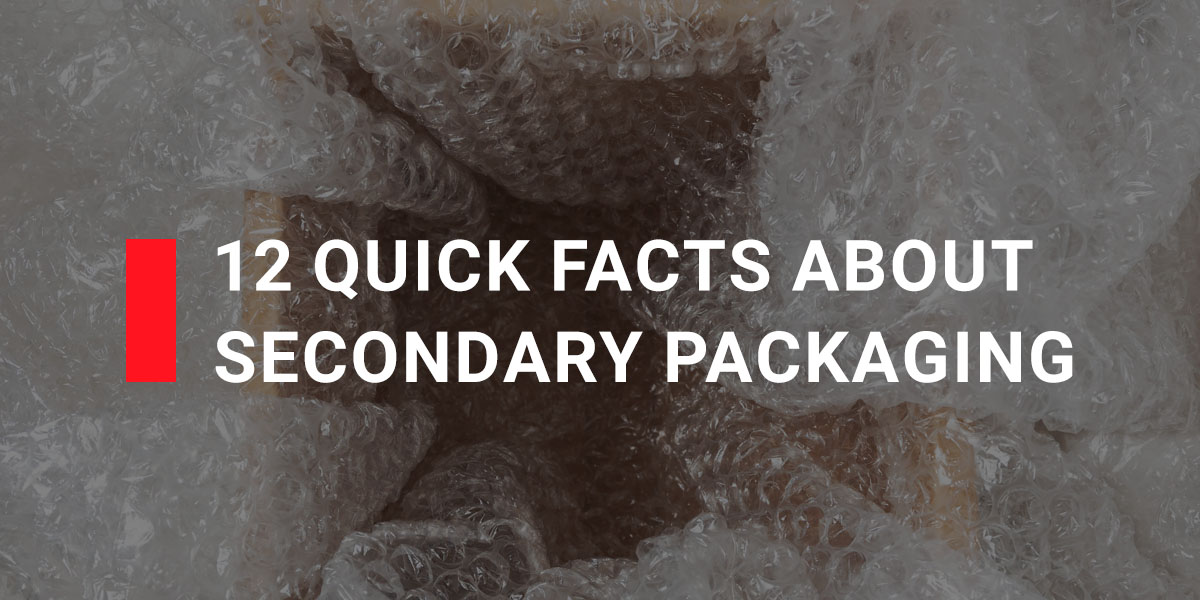16 March 2022 //
Packaging System UpgradeProject Planning
Secondary packaging is ever-evolving, which makes it easy to lose sight of some of the basics. If this sounds familiar, we’re here to help. We’ve compiled a list of key facts to help those newer to the industry learn more about secondary packaging and give packaging veterans a quick refresher. If you’re looking for more information about the importance of secondary packaging, look no further!
What Is Secondary Packaging?
1. Let’s start with the definition. Secondary packaging groups, contains and protects the primary packaging and product during shipping and distribution. It’s a means of delivery and security. Some examples include packing paper, bubble wrap, packing peanuts, shrink wrap and cardboard.
2. Like primary packaging, secondary packaging has two core packaging formats. Flexible packaging uses films. Rigid packaging uses chipboard or corrugate. The two packaging formats can be combined to leverage the benefits of a rigid pack and the cost savings of the film, as in a shrink-wrapped corrugate tray. Which format gets used will ultimately depend on the type of product and how much extra protection it requires.
3. Many times, secondary packaging must endure multiple rounds of shipping and handling. If you’ve ever tracked an online order, you’ve probably noticed how many different facilities it stops at along the way to your doorstep. Secondary packaging must withstand varying degrees of handling to arrive at a retail operation or end-user location in perfect condition, from initial packaging to warehousing and re-palletizing at one or more distribution centers.
4. Some secondary packaging is used as shelf display units instead of being discarded. For example, shrink wrap film is removed from a shelf-ready tray printed with company and product information, and the entire tray is placed on the store shelf. This simplifies shelf restocking, maintains critical shelf space for the store and may improve the product appearance to the consumer. It’s also a great way to make use of materials that would otherwise be discarded.
5. End consumers will interact with secondary packaging at club stores. They buy the complete multicount unit or are exposed to larger shelf-ready trays. Club — or wholesale — stores sell products in bulk rather than individually, making it one of the only places where end customers will encounter secondary packaging.
6. Secondary packaging is not intended for ultra-high aesthetics. It tends to be made from inexpensive, reusable materials such as LDPE shrink film. Secondary packaging’s major purpose is protection — it acts as a buffer between products so they do not get damaged in transit or during shipment. They also protect packages from possible mistreatment by customers who purchase wholesale. In the case secondary packaging is seen by end customers, appearance may be taken into account.
7. After secondary packaging is removed at the store, it is commonly recycled. Secondary packaging creates some extra waste since it’s usually disposed of before it reaches the customers, which is why using biodegradable secondary packaging is often a priority. Recycling secondary packaging is done for financial and sustainability reasons. While secondary packaging does create some extra waste, businesses can decrease their waste output by using appropriately sized packaging. This could also save money by decreasing the weight of your package before shipping.
8. Several factors are considered to determine the proper secondary packaging materials and methods. Some factors include primary packaging needs, material costs, environmental impact, distribution center processes and retail or end-user best practices. Although it may seem self-explanatory, secondary packaging requires care and attention so businesses get the most out of their budget and use processes that work best for them.
9. Secondary packaging is often completed in the same facility as primary packaging. Doing so streamlines production and packaging processes. It can also significantly reduce labor time and costs. This way, the same team who puts together primary packaging can also handle the secondary packaging rather than having to ship the products to a whole new location. Doing this also helps with output speed.
10. Secondary packaging can be completed using manual, semi-automated or fully automated processes. Which process is chosen depends on the product or application and line speed. With an especially quick line speed, one might opt for a fully automated process, whereas if products have a more simple design and slower line speeds, a manual process might work.
11. Secondary packaging equipment may be designed for and operated in many different environments. Examples include dusty environments, refrigerated areas, clean rooms and wash-down applications. It works in any environment where products need to be protected outside of their primary packaging.
12. LDPE shrink film used in secondary packaging provides benefits beyond shipping. It can act as a tamper-evident packaging layer on a shipping unit of medical or food product and allow for easy product identification without the need for opening an outer package. It can also be colored to conceal product contents if an application requires it.
Contact EDL to Upgrade Your Secondary Packaging Equipment
EDL is focused on what happens at the end of the production line. We are committed to advancing secondary packaging technology and offer many different shrink wrapping services and equipment, including Double Tight Wrap (DTW), Roll Wrapper (RW), Integrated Robotic Technology and Integrated Ancillary Equipment.
Our equipment is competitively priced, and we’re dedicated to meeting all our customers’ needs and exceeding expectations. If you’re looking at upgrading your current secondary shrink packaging equipment, planning for a new or expanded line or would like to review a challenging application, contact EDL today. We’re happy to help!

